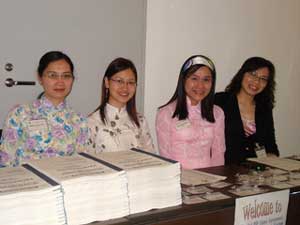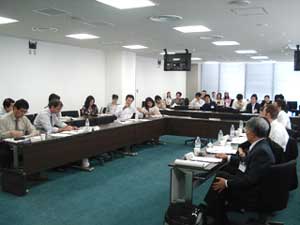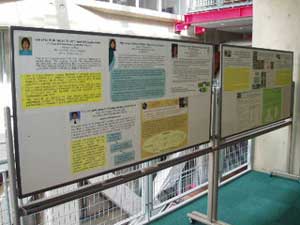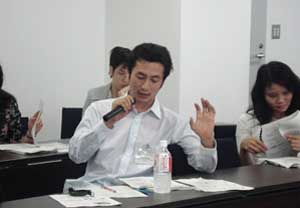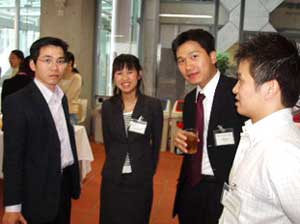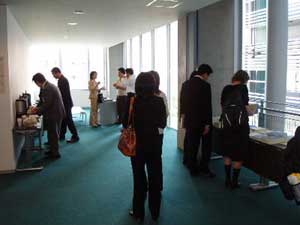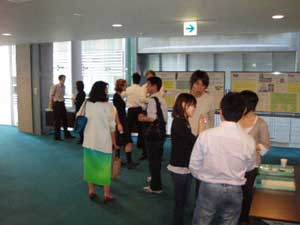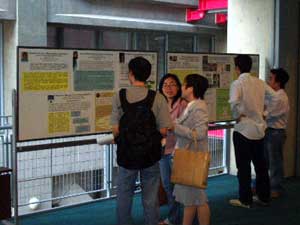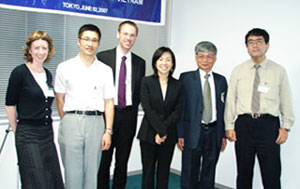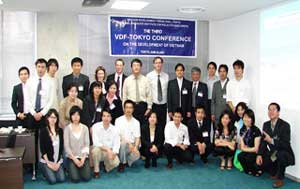|
Vietnam Development
Forum (VDF) - Tokyo THE THIRD
VDF-TOKYO CONFERENCE GRIPS Campus, Saturday, 02 June 2007 CONFERENCE SUMMARY by Nguyen Thi Xuan Thuy, Giang Thanh Long, and Vu Hoang Nam |
||||||||||||||||||||||||
|
The Third VDF-Tokyo Conference on the Development of Vietnam was held at the campus of National Graduate Institute for Policy Studies (GRIPS) in Roppongi on Saturday, 02 June 2007. We welcomed about 50 participants from inside and outside Japan, including professors, researchers, and Japanese and Vietnamese people who have interests in Vietnam's socio-economic development. The Conference consisted of two sessions with seven presentations, in which two keynote presentations were delivered in the morning session, and five presentations were in the afternoon session. We also displayed ten one-page presentations and received a contribution paper from Vietnam. The Conference was opened by Mr. Giang Thanh Long (GRIPS & VDF-Tokyo) with a review of VDF-Tokyofs activities since its establishment in October 2004. Up to now, thirty two monthly workshops and two annual conferences were organized, covering various topics of economics, business, and social issues in Vietnam. VDF-Tokyo also actively cooperated with VDF Hanoi and many institutions in Vietnam, Japan, and other countries to do research, and expand human networking over the years. In the Morning Session, we welcomed two prominent keynote speakers: Prof. Kenichi Ohno (GRIPS Professor, and VDF Research Director), and Dr. Adam McCarty (Chief Economist, Mekong Economics Ltd.). In his presentation, Prof. Ohno talked about drafting the motorbike master plan under market orientation and globalization, which was a major achieve of VDF in cooperation with the Ministry of Industry of Vietnam during the last years. In his turn, Dr. Adam McCarty addressed the transition progress of Vietnam, in which achievements and challenges in the future were analyzed thoroughly. After these two presentations, we had Q & A Session for the participants to exchange views with both keynote speakers. In the Afternoon Session, we welcomed five presenters from inside and outside Japan. Prof. Nguyen Khac Minh, the Director of Vietnam Netherlands Master Program for Development Economics, National Economics University (NEU) in Hanoi, started the session with his quantitative analysis of growth and efficiency performance of the Vietnamese economy since Doi Moi. Dr. Yoko Niimi, a consultant of the World Bank DC, presented her co-authored study with Mr. Pham Thai Hung and Dr. Barry Reilly from University of Sussex, which examined the determinants remittances of internal migrants in Vietnam. Prof. Wade Pfau from GRIPS followed by his co-authored research with Mr. Giang Thanh Long (GRIPS), which studied the impact of international remittances on Vietnamese households. After a coffee break, Dr. Virginie Diaz Pedregal, a researcher of Center for International Cooperation in Agriculture Research for Development (CIRAD) in France, presented her joint work with Dr. Muriel Figuie that identify the place of a consumer movement in a transitional economy in Vietnam. Mr. Woojin Kang, a PhD student of University of Manchester in UK, closed the session by his co-authored paper with Dr. Katsushi Imai (University of Manchester) and Dr. Raghav Gaiha (University of Delhi) on vulnerability and poverty dynamics in Vietnam. After all presentations, we had a special session, in which all participants introduced themselves and their research interests. Many of them expressed their high appreciation for the Conference. On behalf of VDF-Tokyo and the Conference Organizing Committee, Prof. Kenichi Ohno thanked all the presenters and participants, and welcomed them to VDF in Tokyo and Hanoi for research and human networking. @ @ @ Morning Session: Keynote Speakers The morning session welcomed two keynote speakers: Professor Kenichi Ohno from GRIPS and Dr. Adam McCarty from Mekong Economics Ltd.
Keynote Speaker 1: Prof. Kenichi Ohno gDrafting the Motorbike Master Plan under Market Orientation and Globalizationh
Going further with the drafting processes for the current Motorbike Master Plan, Prof. Ohno talked about drafting activities and the contents of the final draft. It was shown that the draft had been made in the new ways, which were greatly different from the traditional drafting processes¾top-down processes with lack of ministerial coordination and lack of business involvement. The draft covered different issues in nine chapters. It was indicated from the presentation that Vietnam was unique in intensive use of motorcycles, urban concentration, as well as motorbike riding style. Currently, there were about 20 million motorbikes in Vietnam, in which most of these were using in urban areas. For instance, Hanoi and HCMC had 2 persons per motorbike, while the other areas had about 6 persons per motorbike. High density of motorbike use in urban areas would create such problems as congestions, accidents, and pollution. Further detailed data showed that the motorbike-automobile ratio in Vietnam was extremely high in comparison with other countries in the regions. Also, urban-rural gap in motorbike density was large. Given these facts and figures, Prof. Ohno said that banning motorbikes without providing alternative transport modes in Vietnam as previously could be considered a policy failure, and that long-term policy should take increasing travel demand, including motorbikes, into account. Specifically, he analyzed two alternative scenarios of transportation uses in Hanoi and HCMC under different assumptions of motorization and transport infrastructure. Prof. Ohno then provided rough estimates of demand forecasts for motorbike, including stock demand and flow demand. The estimates showed that stock demand would be about 33 million motorbikes (or 3 persons per motorbike) in 2020, while flow demand would be about 2.5 million motorbikes under medium-variant assumptions. It meant that the motorbike industry in Vietnam would still be attractive to both domestic and foreign investors. Thus, concrete plan for its development were really necessary. To develop the motorbike industry in Vietnam, the draft discussed a number of relevant issues, including developing supporting industries (SI) and industrial human resources (IHR) [Chapter 4], promoting of urban planning and transportation modes [Chapter 5], reducing traffic accidents [Chapter 6], protecting environment [Chapter 7], and promoting intellectual property rights [Chapter 8], and a set of policy measures [Chapter 9]. For instance, there were six policy suggestions to develop SI and IHR, including strategic FDI marketing, building SI database, as well as creating pilot institutions for practical technical and vocational education and training. At the end of his presentation, Prof. Ohno provided further comments on the draft, as well as the next steps to revise the current draft before submitting to the Prime Minister for approval. Keynote Speaker 2: Dr. Adam McCarty gVietnam: Beyond Transitionh
Dr. McCarty started his presentation by providing numerous evidences about transition processes in Vietnam. The data showed that the transition of output was really smooth and rapid, especially since Doi moi. According to him, the key reason for such transition was that Vietnamese economy had been market-led since early 1980s. This argument was supported by the graph showing the economyfs fluctuations and changes along with the changes in domestic economic policies as well as regional and global economies. In addition to this reason, Dr. McCarty also pointed out some such important factors as changes in agriculture, exports, and possession of literate cheap labor forces. The presentation also indicated that Vietnam had been early achiever of many Millennium Development Goals (MDGs), given it was still low-income country. For instance, poverty rate was half only in a decade (from 58 percent in 1993 to 28.9 percent in 2002, and 19.5 percent in 2004). However, Dr. McCarty also underlined that, along with substantial progresses in both social and economic aspects when moving from a centrally-planned economy to an open-market one, Vietnam was also facing a lot of problems and constraints, which he called gsnakes.h Once Vietnam could deal with these gsnakesh effectively and smoothly, it would go further to obtain more impressive achievements. To be more specific, he provided a short list of gsnakes,h including infrastructure constraint, monopoly corporations, widening inequality, ethic poverty and vulnerability, asset price inflation, and serious corruption problem. Dr. McCarty then went further with detailed analyses of these issues, as well as provided policy directions to solve these problems. For example, the data showed that inequalities in Vietnam had been slightly widening over the past decade, in which the Gini coefficient increased from 0.34 in 1993 to 0.37 in 2004. However, the serious concern was that there was large gap between the richest and the poorest people during the decade, and this gap was widening rapidly. Inequality between regions changed slightly, while inequality within each region widened. Furthermore, decomposition of poverty gap indicated that ethnic minorities remained constantly behind others. From these analyses, Dr. McCarty suggested a number of policies, in which improvement in infrastructure and education would be the key factor for further successes. To conclude, Dr. McCarty argued that, though there still had been various trend-breaking concerns, Vietnam was no longer an economy gin transition,h as it had been in more advanced stage of development, in which development prospects to 2020 looked very good.
Questions & Answers for Prof.
Kenichi Ohno and Dr. Adam McCarty After two keynote presentations, we had about 30 minutes for questions and comments from participants. One participant would like to ask Dr. McCarty for his comments on the impact of asset bubble on the Vietnamese economy. In his response, Dr. McCarty said that assets should be understood in the certain contexts. For instance, some asset bubbles would not have significant impacts on the economy, as the markets will adjust to catch up with changes in the prices of assets. In the case of Vietnam, the most concerned issue on asset bubbles now was the possible stock market bubble. There were two possible sources for the bubbles, given the current situation of the market in Vietnam, where demand had been substantially larger than supply: weak information dissemination and regulations from the government, and possible false financial reports from stock issuing companies on the market. According to Dr. McCarty, macroeconomic management, especially price and exchange rate management, played an important role in preventing such possible bubbles. The current case of Vietnam, according to him, was different from Thailand under the Asian financial crisis in 1997-1998, as Thailand was attracting huge short-term capital flows under persistent fixed exchange rate regime. Adding some comments on the issue, Prof. Ohno thought that, to some extent, land bubble and corruption might not have huge impacts on the economy. According to him, one of the most emerging issues for Vietnam was widening unfairness among people, as this problem would create social instability, which in turn would influence economic growth negatively. Prof. Ohno and Dr. McCarty agreed that corruption was really difficult to solve immediately, given the current legal framework and administrative capacity of the country. They both reached to a common suggestion that improving accountability within government and with public would be an important step to deal with corruption. Another question about the role of FDI and public investment in the economy was delivered to both Prof. Ohno and Dr. McCarty. A participant argued that the Vietnamese economy had relied significantly on FDI, so the growth rate might be changed with a slight change in FDI inflows. Dr. McCarty responded that new FDIs had been more diverse than before, so that shrinking FDI would not influence much on the economy. However, he said that, along with diverse FDI inflows, Vietnam would also face various investment risks, particularly when global economy fluctuated, or huge capital outflows occurred in the economy. Thus, he again emphasized that macroeconomic management was important. To illustrate the possible impact of FDI more specifically, Prof. Ohno commented that big FDI inflows would promote economic growth, but they would also push wage rates and land prices. If these factors increased too fast, and out of control, they would in turn slow down the economic growth. Regarding public investment, Dr. McCarty argued that the current Vietnam always needed more money for investments in social and economic infrastructure. However, one critical thing was that we never discussed about efficiency of these investments. Therefore, what and how to invest needed to be considered thoroughly before making decisions. Many participants were interested in the issue of policy-making processes in Vietnam, and they would like to know comments and suggestions from both keynote speakers about how to improve or renovate these processes. In response, Prof. Ohno said that concrete coordination between ministries would be the most important factor. More specifically, he gave an example for promoting industrial human resource, in which all relevant industries should coordinate with each other in specifying development strategies for the whole industrial sector, as well as individual industries. Under such coordination, the number of labors in terms of skills or ages would be determined to meet the demand of each industry. Answering the question at broader context, Dr. McCarty suggested that we should have independent and strong civil societies, which focused on different objectives, so that people would understand their responsibilities and rights to the country, in which corruption and other social problems would be dealt with. @ Afternoon Session: Presentations
Presentation 1: Prof. Nguyen Khac Minh gGrowth and Efficiency Performance of the Vietnamese Economy since Doi moih @
The hypothesis tests for production function showed that constant elasticity of substitution (CES) form was appropriate for the Vietnamese economy in the past two decade. Moreover, the output elasticity of labor was much greater than that of capital, so that the Vietnamese economy was relied more heavily on labor than capita in the production processes. Decomposition of economic growth showed that capital, labor, and total factor productivity contributed 45.3 percent, 34.5 percent, and 19.7 percent to GDP growth, respectively. Both SFPF and DEA were used to estimate technical efficiency measures for three sectors. In SFPF approach, it was found that the average technical efficiency of the whole economy during the study period was only 72 percent, and the average technical efficiency of the services sector was much higher than those of the agricultural and industrial sectors. In DEA, the average technical efficiency estimates were slightly different under different specification of production technology. In general, DEA provided higher technical efficiency estimates than SFPF. To detect these differences, Prof. Minh used Spearman rank correlations of efficiency rankings. The estimated results showed that the estimates from two approaches were not significantly different. Going further with estimates of TFP for three sectors, Prof. Minh presented the estimated TFP and its decomposition for these sectors in the study period. He also conducted eight hypothesis tests to see whether a sector was stably more productive than the others. All the tests showed that the industrial sector was persistently more productive than the services sector, which in turn was stably more productive than the agricultural sector. In general, all the approaches confirmed that the industrial sector had most contribution to GDP growth since Doi moi. The Q&A section was started by a question about the possible of endogeneity in the estimates, as the coefficients representing output elasticities of capital and labor were relatively high. In response, Prof. Minh said that there would be a possibility of this problem because all the estimates were based on aggregate macroeconomic data. However, he pointed out that these coefficients for each sector were appropriate, as each sector would have different technology, and thus technology will have different impacts on the growth of each sector when we compared them. Another question from the participant was about how the mentioned techniques were significantly different from the traditional way of measuring technological changes, i.e. Solow residual. Prof. Minh responded that the techniques used in his paper, especially SFPF model, could capture and decompose so-called residual into technical change and technological change. This decomposition was really important in productivity and efficiency analysis. One participant would like to know how robust the estimates were. In his response, Prof. Minh said that he used three approaches to measure technical efficiency of each sector as well as the whole economy. Also, he used hypothesis tests to check whether the estimates were consistent. To add some comments for this question, Mr. Long (VDF-Tokyo) said that the critical issue of the paper was that it used aggregate data to estimate technical efficiency for different economic sectors, which obviously had different technology specifications. He suggested that the paper could be improved by conducting a factorial effects model, in which various possible determinants of productivity and efficiency changes could be examined. Presentation 2: Dr. Yoko Niimi gDeterminants of Remittances: Recent Evidence using Data on Internal Migrants in Vietnamh (with Pham Thai Hung and Barry Reilly) @
To start the main contents of the paper, Dr. Niimi made a brief overview of various theoretical models to explain remittance behavior, such as altruism, exchange/self-interest, risk-sharing motives, or bequest motive. She then described data source and the empirical model to analyze domestic remittances in Vietnam. Data were mainly based on the 2004 Vietnam Migration Survey conducted by the General Statistics Office (GSO). Various factors, such as age, gender, and educational attainment of the migrants, were examined in the model. A number of interesting estimates were found and discussed. For example, the migrantsf educational level had a positive relationship with their remittances, and closer ties between migrants and those left behind also increased remittances. Also, earnings and remittances of the migrants were positively related. To conclude, Dr. Niimi showed that these findings supported a number of theories on remittances, such as co-insurance theory. She also emphasized that migration and remittances had been an important source to insure against uncertainties of the households, especially in rural areas. The Q&A section for this paper was ignited by a question about the differences between migrants from the North and the South, and how representative the data were. Dr. Niimi responded that data were not really representative for the whole country, so that it was difficult to provide a concrete conclusion of how the migrants from the North were different from those from the South in remittance behaviors. Another participant argued that there would be a number of networks, rather than family network, for the migrants, and they might influence significantly remittance behaviors of the migrants. In her response, Dr. Niimi did agree with the participant, but the data did not have any of such information for her and colleagues to examine. According to a participant, individual and household characteristics of the people left behind would also be important factors. He argued, for instance, that there might be no need for the migrants to send money to their family members or relatives at the hometown if these people had enough income. Dr. Niimi again did agree with this argument, but she also again explained that there was no such information in the survey. It was also unfortunate that the survey had no links with any of the Vietnam (Household) Living Standards Surveys, so that it was difficult to make assumptions on this matter. One of the common agreements between the participants was about the possible multi-collinearity or autocorrelation between variables of the model, such as age, earnings, and education would be influenced by each other. Dr. Niimi replied that, by adding all these possible variables to the model, she could see their certain impacts on remittance behavior of the migrants, but, at the same time, it was really difficult to control for exact relationship between these variables. Another relevant comment was about residence registration as dummy variable in the model. A participant argued that this might already capture some characteristics of the migrants, which were included in the model, and thus the model might also have endogeneity problem. Dr. Niimi thanked all the participants for their comments, and she thought that these comments would be important inputs for revising the paper. Presentation 3: Prof. Wade D. Pfau gRemittances in Vietnam during Economic Integration: Characteristics and Impacts on Household Welfareh (with Giang Thanh Long) @
Before analyzing the findings, Prof. Pfau reviewed some existing studies for Vietnam, and it was shown that there had been few studies on this emerging topic in Vietnam. He then made a description of data, in which advantages and drawbacks of data for the paper were discussed. Decomposition of both domestic and international remittances showed that these flows were diverse, depending on household characteristics. For example, during the study period, the percentage of domestic remittances in the total remittances increased. Also, it is shown by region that the Southeast region, particularly Ho Chi Minh City, received a large amount of international remittances, and this is followed by the Red River Delta. By family relations, children were the largest source of international remittances, as indicated in the VLSS 1992/93 and 1997/98. Going further with the household spending of remittances, Prof. Pfau showed that most of the remittances were used for consumption, and only little for education and other investments (such as farm and non-farm production). Due to time limitation, Prof. Pfau briefly explained how he could estimate Gini coefficients to analyze the impacts of both domestic and international remittances on householdsf real per capita income and expenditure. He would offer any questions and comments on this issue. The first question from a participant was about how gifts could be estimated in the paper, in addition to remittances in cash. Prof. Pfau responded that all in-kind transfers were converted to monetary terms, so that all the estimates of the paper were in monetary terms consistently. Another participant would like to know about more concrete definition of consumption in the paper, as well as how such consumption was different from spending for education. In response, Prof. Pfau said that, in the surveys, there were numerous categories to be defined as in household consumption, and the question about spending on education was included. Prof. Pfau also indeed wanted to know how remittances were spent for health care, especially in the elderly households, but data did not provide this important piece of information. Though, he agreed with the participant that it was sometimes difficult to distinguish such confusable definitions. The last question was about relation between senders and receivers of remittances, particularly whether remittances always go from the rich to the poor family members as assistance, or these flows were as insurance mechanism. Prof. Pfau responded that, by using cross-sectional data, it was really difficult to make concrete conclusions about these issues, and hoped that the coming paper using panel data could explain partly these interesting questions. Presentation 4: Dr. Virginie Diaz Pedregal gWhat is the Place of a Consumer Movement in a Transitional Economy?h (with Muriel Figuié) @
Her research was conducted and analyzed by using data from the semi-structured interviews with key officers and the members of VINASTAS, as well as some consumers in Vietnam. The main objective of the research was to explore the limitations of VINASTAS under economic transformation in Vietnam, and from which policy implications could be drawn to protect the consumers in Vietnam. The presentation was begun by an overview on the history of economic development in Vietnam, in which VINASTAS was established to standardize quality of goods, and provide information and protection to consumers in Vietnam. With the current structure and operational style, Dr. Pedregal argued that VINASTAS was facing a number of problems, such as low independence and unattractive to young population (who are major consumers of the country). And as such, under swift social and economic changes with new membership of WTO, VINASTAS might not fulfill its core responsibilities. To deal with these problems, as Dr. Pedregal argued, VINASTAS should overcome some urgent operational constraints, including limited budget, lack of professional staff, and lack of power. The Q&A section was started by a question about how consumers in developed countries were protected, and how much different between operation of VINASTAS and a typical consumer protection organization in developed countries. In her response, Dr. Pedregal said that people could go to court for claiming bad quality products. For the latter part of the question, she said that the structures of consumer protection organizations were diverse, depending on certain economic and social development level of each country. Another participant wanted to know further about operational limitations of VINASTAS in protecting consumers in Vietnam. According to Dr. Pedregal, there were many limitations as she listed in the presentation. However, she thought that the most concerned issue was decision-making mechanism of this organization, because it had followed top-down mechanism, while such kind of organization should follow bottom-up decisions because consumers were its gcustomers.h One participant argued that the operational limitation of VINASTAS could also be seen through the number of cases claiming to VINASTAS per year, and how many of them could be solved successfully. Dr. Pedregal fully agreed with this argument, and she said that it could be considered an operational failure for VINASTAS since only 400-500 complaints per year in Vietnam, whose population was about 83 millions in 2006. Also, she pointed out that there had been various kinds of counterfeit goods in markets, and thus it would be really complicated and difficult for both producers and consumers to deal with this problem directly or indirectly via VINASTAS. In addition to the responses from Dr. Pedregal, Prof. Ohno also made some comments. He said that, under the current economic development and management in Vietnam, it was obvious to see a lot of complaints from consumers, and this might be over the capacity of VINASTAS with its current operational structure. Therefore, it would be rational for consumers in Vietnam not go to VINASTAS to claim any problems. He thought that, without systematic reforms of operational structure and decision-making mechanism, VINASTAS would be a clear failure in protecting consumers in Vietnam. Presentation 5: Mr. Woojin Kang gVulnerability and Poverty Dynamics in Vietnamh (with Katsushi Imai and Raghav Gaiha) @
Mr. Kang started his presentation by making an overview of poverty reduction in Vietnam during the past decade. It was shown that Vietnam had achieved really impressive poverty reduction under high economic growth. For instance, poverty rate reduced from 58 percent in 1992/93 to 19.5 percent in 2004. Along with this, Vietnam was also considered an early achiever of Millennium Development Goals (MDGs). However, as indicated in a number of studies, many groups of people in Vietnam were living under vulnerable conditions, which could easily make them poor. Therefore, identifying the determinants of vulnerability would be an important task in dealing with poverty, particularly chronic poverty, in Vietnam. The presentation was then continued with an analytical framework, in which gVulnerability as Expected Poverty (VEP)h indicator was considered a function of various possible factors. This indicator was represented by log of per capita consumption. Four combinations of poor and non-poor statuses were analyzed. Also, a list of explanatory variables, including gender, ethnicity, and regions, was presented with a detailed elucidation. Mr. Kang then showed the estimated results on the change of poverty status from 2002 to 2004 using multinomial logit models. Many interesting findings were explained. For example, age of the household head was positively and statistically significant in moving people from both poor and non-poor statuses in 2002 to poor status in 2004. It was also implied that ethnic minorities had more probabilities to become poor than other ethnic groups, especially Kinh people. The findings for other living conditions, such as electricity and access to market, also showed that they were significantly important to reducing vulnerability, and thus poverty, for the people in Vietnam. Based on these findings, Mr. Kang emphasized that creating formal mechanisms to deal with aggregate and idiosyncratic shocks was extremely important for fighting poverty in Vietnam. The Q&A was really lively with a number of questions and comments from participants on models and findings. One of the common concerns of the participants was about extremely high and statistically significant coefficients for land variable in all models. Most of them suggested that Mr. Kang check the estimation, as well as find appropriate explanation for this issue, as land could be evaluated in various kinds and use purposes. Regarding poverty measurement, many participants also wondered how the estimated results using poverty lines by GSO would have been different if he used international poverty lines. Another argument from a participant that only educational attainment could not explain whether people would change their poor or non-poor status, and he suggested that education variable be considered in interaction terms with other variables, such as age or gender. Mr. Kang thanked for this interesting comment, and he would check to see how the results would be different. Based on the definition of VEP, a participant commented that changing status from poor and non-poor statuses in 2002 to poor status in 2004 might explained by more fluctuation in error term of the model. Therefore, it might be that higher variance of model would indicate an escape from poverty. Regarding dummy variables representing ethnic minorities, one participant said that it would not be good to focus on many ethnic minorities in Vietnam, who accounted for a very small part of the total population. In addition, he said that, ethnic minority people were usually living in very poor and isolated regions, and thus their poor status did not change over time was understandable. He suggested that these dummy variables be only considered with Kinh, Chinese, and other ethnic groups, as Kinh people accounted for a major part of the total population, while Chinese usually had higher per capita income than both Kinh and other ethnic people Mr. Kang thanked for these interesting and useful comments, and he thought they would be crucial ideas for improving paper. @
At the end of the Conference, Prof. Kenichi Ohno made closing remarks. He thanked all the participants for their active participation in the Conference, and hoped that VDF would be a good place for them to meet and exchange research ideas. Also, he would like to invite all the participants to present studies at VDF at their convenient time. Photos
|
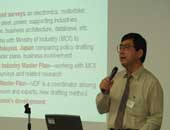 Prof.
Kenichi Ohno began his presentation by talking about VDFfs recent
research activities, particularly the cooperation between VDF and
Ministry of Industry (MOI) of Vietnam in drafting the Motorbike
Master Plan, which would be the main topic of his presentation. As
he repeatedly mentioned, Vietnam was facing two fundamental problems
in policy formulation, i.e. lack of business involvement and lack of
coordination within government. He emphasized that these problems
were really unique in Vietnam, as he could not see any of such
problems in Japan, Malaysia, or Thailand after a number of research
visits in these countries. To be more specific, he showed how the
drafting processes for the Industrial Master Plan in Vietnam were
substantially different from those in Malaysia and Thailand.
Prof.
Kenichi Ohno began his presentation by talking about VDFfs recent
research activities, particularly the cooperation between VDF and
Ministry of Industry (MOI) of Vietnam in drafting the Motorbike
Master Plan, which would be the main topic of his presentation. As
he repeatedly mentioned, Vietnam was facing two fundamental problems
in policy formulation, i.e. lack of business involvement and lack of
coordination within government. He emphasized that these problems
were really unique in Vietnam, as he could not see any of such
problems in Japan, Malaysia, or Thailand after a number of research
visits in these countries. To be more specific, he showed how the
drafting processes for the Industrial Master Plan in Vietnam were
substantially different from those in Malaysia and Thailand.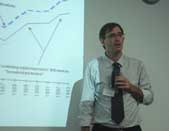 In the
second part of the morning session, we welcomed Dr. Adam McCarty,
Chief Economist of the Mekong Economics Ltd. in Hanoi. He has been
working in Vietnam for more than 15 years as a consultant for a
number of domestic and international organizations in Vietnam.
In the
second part of the morning session, we welcomed Dr. Adam McCarty,
Chief Economist of the Mekong Economics Ltd. in Hanoi. He has been
working in Vietnam for more than 15 years as a consultant for a
number of domestic and international organizations in Vietnam.
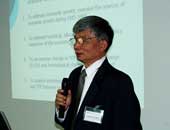 The
objective of this paper was to use different approaches to decompose
growth factors, as well as measure technical, allocative, and
economic efficiencies of the Vietnamese economy in the past two
decades. Prof. Minh began his presentation by reviewing different
techniques that he would use in the paper. These techniques included
decomposition of growth factor, Malmquist productivity indices,
stochastic frontier production function (SFPF), and data envelopment
analysis (DEA). These techniques were then applied with the
macroeconomic data of the period 1986-2006 for three main economic
sectors, namely agriculture sector, industrial sector, and services
sector.
The
objective of this paper was to use different approaches to decompose
growth factors, as well as measure technical, allocative, and
economic efficiencies of the Vietnamese economy in the past two
decades. Prof. Minh began his presentation by reviewing different
techniques that he would use in the paper. These techniques included
decomposition of growth factor, Malmquist productivity indices,
stochastic frontier production function (SFPF), and data envelopment
analysis (DEA). These techniques were then applied with the
macroeconomic data of the period 1986-2006 for three main economic
sectors, namely agriculture sector, industrial sector, and services
sector. 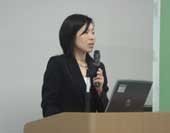 Dr. Yoko Niimi from
the World Bank was the second presenter of the session. In her
presentation, she discussed recent findings of her co-authored
research on domestic remittances in Vietnam. Domestic migration and
remittance, according to her, were important policy issues in urban
planning and labor market in Vietnam, but there had been little
empirical work on these topics. The main objective of the research
was to examine the key factors that influence the remittance
behavior of domestic migrants in Vietnam.
Dr. Yoko Niimi from
the World Bank was the second presenter of the session. In her
presentation, she discussed recent findings of her co-authored
research on domestic remittances in Vietnam. Domestic migration and
remittance, according to her, were important policy issues in urban
planning and labor market in Vietnam, but there had been little
empirical work on these topics. The main objective of the research
was to examine the key factors that influence the remittance
behavior of domestic migrants in Vietnam. Also
discussing about the impacts of remittances on the household welfare
in Vietnam, Prof. Wade Pfau presented the findings from his recent
co-research using the Vietnam (Household) Living Standards Surveys
1992/93, 1997/98, 2002, and 2004. An overview of remittance flows in
Vietnam in the past decade showed that both international and
domestic remittances increased significantly, especially the
international flows. According to Prof. Pfau, however, the impact of
remittances on the economy and households was not unclear from
theoretical perspective, and thus this research would seek to
quantify the impacts of remittances of income and expenditure
inequality in Vietnam under economic transition.
Also
discussing about the impacts of remittances on the household welfare
in Vietnam, Prof. Wade Pfau presented the findings from his recent
co-research using the Vietnam (Household) Living Standards Surveys
1992/93, 1997/98, 2002, and 2004. An overview of remittance flows in
Vietnam in the past decade showed that both international and
domestic remittances increased significantly, especially the
international flows. According to Prof. Pfau, however, the impact of
remittances on the economy and households was not unclear from
theoretical perspective, and thus this research would seek to
quantify the impacts of remittances of income and expenditure
inequality in Vietnam under economic transition. After
having about 30 minutes for tea break and one-page presentation, we
continued the Conference with Dr. Pedregalfs presentation on one of
the most current important social issues in Vietnam, i.e. the rights
of consumers in Vietnam, and the role of Vietnam Standard and
Consumers Association (VINASTAS) to protect them.
After
having about 30 minutes for tea break and one-page presentation, we
continued the Conference with Dr. Pedregalfs presentation on one of
the most current important social issues in Vietnam, i.e. the rights
of consumers in Vietnam, and the role of Vietnam Standard and
Consumers Association (VINASTAS) to protect them. The
last presenter of the Conference, Mr. Woojin Kang, provided an
analysis on poverty and vulnerability in Vietnam. This research used
a set of panel data from the Vietnam Household Living Standards
Survey (VHLSS) in 2002 and 2004.
The
last presenter of the Conference, Mr. Woojin Kang, provided an
analysis on poverty and vulnerability in Vietnam. This research used
a set of panel data from the Vietnam Household Living Standards
Survey (VHLSS) in 2002 and 2004.